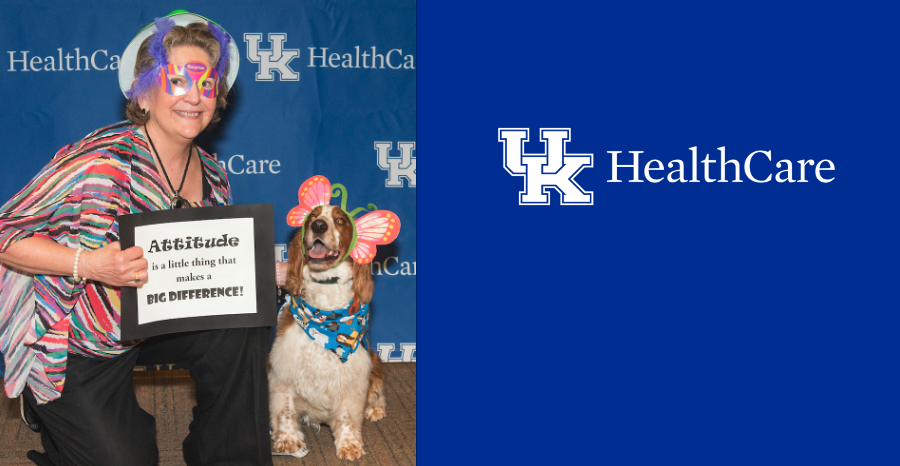All things animal-assisted therapy with Susan Lephart, PhD

Our animal-assisted therapy program does more than just brighten spirits. Studies have shown that incorporating animals into the therapeutic process can also lower stress-related cortisol levels, decrease anxiety and lower blood pressure and pulse.
With many of our volunteers returning on Monday, April 19, we’re thrilled to report that this includes our therapy dogs and their handlers, as well. To celebrate the good news, we chatted with Susan Lephart, PhD, our animal-assisted therapy coordinator.
Therapy dogs returned to work Monday. How important is the animal-assisted therapy program – and will it be any different because of COVID-19 protocols?
The return of the work of the animal-assisted program after more than a year means a great deal to the therapy teams and to me. We are returning with some different protocols and standards, however, as with most things during the pandemic. As always, the safety of the volunteers who own and handle the dogs and the people with whom they interact is paramount.
Infection prevention & control has provided stellar guidance on our gradual return which will allow us to begin visits with staff again. We are working to ensure these visits are conducted in a one-on-one manner with social distancing. Each interaction with the therapy dog will be preceded and followed by hand sanitizing and I will be supervising every visit.
For this stage of our return, the therapy teams won’t be visiting patients and families. While much of this is different, it’s a logical and safe approach to bringing the volunteers and their dogs back into the hospital environment in a safe manner. Hopefully, by the end of June or early July, we can gradually begin to return to patient and family visits and address anxiety, depression and stress for all throughout the enterprise.
Throughout this pandemic, the Canine Counselors have found ways to lift people up through virtual visits and other creative and non-traditional approaches. To know that UK HealthCare supports and believes in our work enough to allow us to continue the program and come back again speaks volumes.
How many therapy dog teams are available?
We currently have 32 teams. Our numbers dropped during the pandemic as we sadly lost therapy dogs as well as one of our handlers. Sandy Gragg, who was Fiona’s owner and handler, lost his battle with COVID last December and is missed terribly by all of us – as are the dogs who crossed over the rainbow bridge.
What’s a typical day like for a therapy dog?
Therapy dogs live pretty much the same kind of life as most pets: in loving homes. The biggest difference is that when they put on their vest or special bandana to go to work, they get very excited and are ready to go.
The dogs must be freshly groomed, so visit days begin with that, then move on to loading up in their owners’ car and heading to the hospital.
We try to limit their visits to two hours as they absorb a great deal of stress during their work. I call them stress sponges, as they sense our anxieties and issues and work to alleviate them. When the dogs return home, most are pretty tired and will sleep for a few hours.
If I see a therapy dog in the hospital, can I approach it? What rules should I follow around the dogs?
Always ask before interacting with any animal. While the therapy dogs are trained to love hugs, pets and lots of attention — and usually wear a vest or bandana while working — there are other dogs with vests or scarves who might be service dogs or emotional support animals.
Approaching either of these dogs could be a very different experience, because when service dogs put on their vest they are working for their handler only and don’t need distractions or outside attention. Emotional support animals may be friendly, however, they require no training and may be friendly only to their owner.
What’s your favorite part of your job?
There are many aspects that I love about my work. The people that I am privileged to work with are probably at the top of the list. These volunteers are remarkable people who are committed to their work.
The other aspect that is what drives me is the work of the dogs and watching the daily differences they make in life after life. Whether it’s a staff member who just lost a patient or a patient who just received bad news about their diagnosis, you can watch their entire countenance change when they see and interact with one of the dogs.
What are the benefits of having a dedicated animal-assisted therapy program in the hospital?
Our program aligns with similar “best of” facilities like Mayo Clinic, UCLA and Johns Hopkins – and this speaks volumes. In having a dedicated program, the patients, families, staff and faculty know that there is a regular opportunity to have therapy dogs available for their assistance. When we are at full capacity, we have teams that visit all areas of the enterprise at all hours of the day and night. We also have our “Canine Counselors…AWAY” group who will dispatch on very short notice to help in emergencies.
All of this is possible because of the structure and organization of a dedicated program. My hope is to continue to keep our program at the top nationally as we grow and expand our work. We are so grateful to return and look forward to seeing as many smiling faces as possible in the weeks to come.




